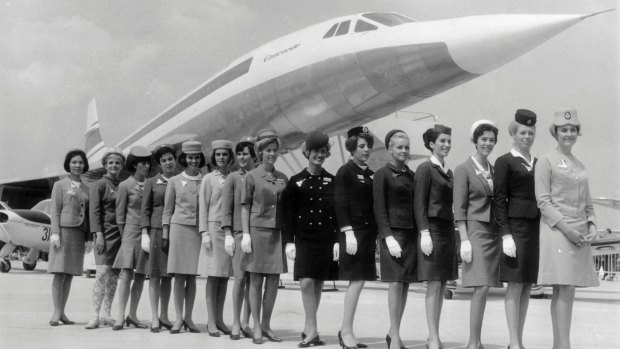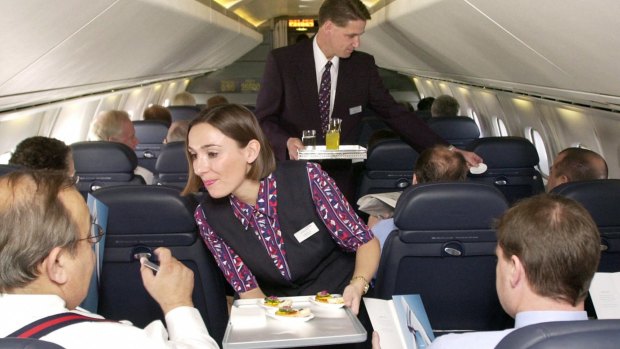This was published 6 years ago
Concorde supersonic jet: Last Concorde to fly now at Aerospace Bristol museum
By Steven Overly
The Concorde jet dazzled when it began hurling passengers from Washington to London at twice the speed of sound in 1976. The most fortunate air travellers - be they wealthy or upgraded from first class - could depart the nation's capital around lunch and touch down in time for a late dinner.
Of course, they probably weren't hungry yet. The total flight time to cross the Atlantic, including takeoff and landing, clocked in at less than four hours. (Add five more for the time difference, though.) Today, 41 years later, that same flight takes more than twice as long.
Indeed, the world never opened up in the way travel enthusiasts expected during the Concorde's early days. And it was revealed recently that the final aircraft to ever take flight, back in October 2003, will be grounded permanently at a museum in Bristol, England.

Flight attendants from different airlines line up in front of the Concorde in 1960.Credit: Getty Images
The $32 million Aerospace Bristol museum is set to open at the end of the British summer this year.
Most artifacts find their place behind museum glass after their utility runs its course. The fast march of innovation moves forward and the technology simply cannot keep pace.
But the Concorde never realised its full potential. Commercial supersonic flights no longer exist today, and not because we have moved on to faster or better technology. In the four decades since the Concorde first entered service, no commercial plane has flown faster.

On board the Concorde supersonic jet. ""You have a proper sit-down French meal, which takes two and a half to three hours."Credit: Alamy
There are now a crop of start-ups looking to change that - chasing a dream that seemed to have been realised long ago. They aim to re-achieve commercial air travel at supersonic speeds, but without the technical and financial challenges that ultimately stymied the Concorde.
In that way, the Concorde is both a relic of the past and a vision of the future.
"Where else in tech do you have a capability and then you go backward? It's kind of crazy on the face of it," said Blake Scholl, the founder and CEO of one such start-up, Boom Technology.
The Concorde was a feat of engineering when it was first unveiled in 1969. A project of the British and French governments, the aircraft could hold up to 100 passengers and traverse the Atlantic at nearly 2253 km/h, more than twice the speed of a standard plane. Its ultra-slim body and drooped nose gave the Concorde a look more akin to a military jet or space shuttle than a standard commercial airliner.
"It was quite the dream and it was a logical dream, because up until the Concorde, every innovation in airlines was bigger and could fly faster and carry more," said F. Robert van der Linden, the curator of air transportation at the Smithsonian's National Air and Space Museum.
Archive photos and footage from the '70s show ceremonious unveilings on tarmacs and flight attendants wheeling carts of champagne. The celebrated Concorde with its promise of a luxury experience and time-bending speeds seemed to capture the curiosity of frequent travellers from its first flight to its last.
As one passenger, David Welsh of suburban Washington told The Washington Post in November 1994, "A lot of my colleagues have taken it, and I wanted to see what it would be like before it's gone."
Indeed, Welsh was aboard the last supersonic flight to depart from Washington's Dulles Airport. Service would continue out of New York's John F. Kennedy Airport for roughly another decade, but the dream of the Concorde encountered real-world obstacles that would ultimately prove insurmountable.
Flying at such high speeds meant the plane had to overcome considerably more drag than your standard plane, van der Linden said. The Concorde guzzled four times as much fuel per passenger as a standard airline, according to past reports, which caused both the price of tickets and the toll on the environment to rise precipitously.
A one-way ticket across the Atlantic cost north of $US6000 ($A7961) by the time the Concorde took its final flight. That price was certainly out of the budget for an average family of tourists, and even government and business travellers would come to balk at it during more difficult economic times, The Post previously reported.
"It takes so much more power and fuel that it just is not possible for it to be cheaper than subsonic travel, which is why today we travel at the same speeds as we did in 1957," van der Linden said.
Then came concerns about the noise.
Regulators halted the Concorde's travel over land after complaints that the supersonic boom caused by travelling faster that sound was a safety issue and nuisance. That significantly limited the number of routes the Concorde could fly, especially at a time when long-distance air travel was less common and more difficult.
A fiery crash near Paris that killed 113 passengers and crew members on July 25, 2000, grounded the global fleet of Concordes - which even at its height was just 20 planes. Safety improvements allowed them to take flight again more than a year later, but their return to the skies would be brief.
The planes were retired in 2003.
Van der Linden took part in one of the final Concorde flights. On June 12, 2003, one of the planes was flown for the final time to the United States and put to rest at the Smithsonian's aircraft display center in Chantilly, Va.
"You have a proper sit-down French meal, which takes two and a half to three hours, you look out the window and you're home," van der Linden said. "It can't be beat, but you also can't pay for it, either."
Supersonic travel has seen a renaissance in recent years. Small companies like Boom Technologies and Aerion are developing aircraft that will travel at speeds even faster than the Concorde, relying on technological advancements in recent years to help make the planes more fuel efficient and cost effective.
Scholl at Boom Technologies said improvements in engines, fuel storage, aerodynamics and materials all add up to planes that are lighter and more fuel efficient than those of the past. But the new supersonic plans are still concepts today. Scholl's company is building a two-seater plane that he hopes will prove that the technology exists to make larger planes in the future that can accommodate business-class passengers.
"There is no single silver bullet," Scholl said. "There are a whole bunch of carbon bullets that add up to the efficiency you need."
So even as the last of the Concordes comes to its final stop, the innovation that the airplane embodies may still have wings.
"From my perspective, it is great to see when people put their minds and resources and focus on something that looks almost impossible, [and] actually get it done and make it something that is workable," said Ali Bahrami, the vice president of civil aviation at the Aerospace Industries Association. "I don't believe the idea is dead."
The Washington Post
See also: Six incredible planes you'll never get to fly on
See also: Six 747 engines - the world's largest plane rolls out
Sign up for the Traveller Deals newsletter
Get exclusive travel deals delivered straight to your inbox. Sign up now.